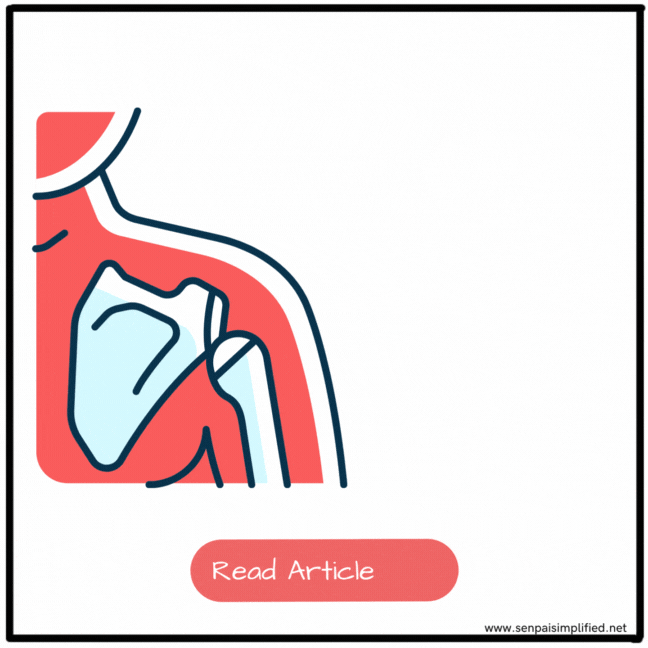Your cart is currently empty!

Shoulder Joint
The Shoulder Joint is the joint with the highest range of movement in the body. Everything a pre-clinical medical student needs to know about the shoulder joint, you can learn by reading this article.
Type
The shoulder joint is a multiaxial synovial joint. It is a joint of the ball and socket variety.
Articular Surfaces
The ball of the ball socket joint, is the head of the humerus. The socket is the glenoid fossa of the scapula. The head of the humerus is 4 times the surface area of the glenoid fossa.
Capsule
The capsule is lax and attached medially to the margins of the Glenoid labrum and laterally to the anatomical neck except inferiorly & extend downwards to the surgical neck of the humerus. The synovial membrane is attached to the margins of articular surfaces and lines the fibrous membrane of the joint capsule.
Bursae
The synovial membrane protrudes through apertures in the fibrous membrane of the capsule to form bursae. Bursae related to shoulder joint,
- Deltoid/ Sub-acromial bursa – This is the largest bursa of the body. this has no communication with synovial fluid of joint
- Sub-scapular bursa – Communicating bursa)
- Infraspinous bursa – Can be communicating or not)
Ligaments
- Glenohumeral ligaments – These are intra-capsular ligaments
- Upper
- Middle
- Lower
- Transverse humeral ligament – Extends between the two tuberosities. This is an extra -capsular ligament –
- Coracohumeral ligament – This is also extra-capsular.
- Coracoacromian ligament – This projects superiorly via coracoacromian arch. This is also an extra-capsular ligament
Muscles
- Rotator Cuff Muscles – They blend with each other and the joint capsule but doesnt cover the inferior aspect of the capsule.
- Long head of biceps brachii (above)
- Long head of triceps brachii (below)
- Deltoid
- Pectoralis Major
Blood Supply
According to Hilton’s law, this joint is supplied by branches of the same artery of which other branches supply the muscles that span across the joint and involve in movements across the joint. They are,
- Circumflex humeral vessels
- Subscapular vessels
- Suprascapular vessels
Innervation
- Axillary nerve
- Supra scapular nerve
- Musculocutaneous nerve
Movements
Abduction
- Initiation 15 degrees – Supraspinatus
- From 15 to 90 degrees – Deltoid
- Above 90 degrees – Trapezius and Serratus Anterior
Adduction
- Pectoralis major
- Latismus dorsi
- Biceps Brachii
- Teres Major
Flexion
- Pec. Major
- Coracobrachialis
- Deltoid (anterior fibres)
Extension
- T. Major
- Latismus Dorsi
- Deltoid (Posterior fibres)
Medial Rotation
- Pec. Major
- Teres Major
- Latismus dorsi
- Deltoid anterior fibres
- Subscapularis
Lateral Rotation
- Infraspinatus
- Teres Major
- Deltoid (Posterior Fibres)
Clinicals
For interest’s sake, let’s look at a few clinical instances where the above knowledge can come in handy.
Shoulder dislocation
Abducted, flexed and laterally rotated position is the most vulnerable position for dislocation. This is the most common joint to dislocate. Antero-inferior dislocation is the commonest out of others, as the joint least protected inferiorly, only by redundant capsule and tendon of the long head of triceps. First dislocate in to sub-glenoid position and then passes anteriorly into sub-coracoid position because of the muscle pull.
The head of the humerus is held adducted by shoulder girdle muscles and internally rotated by subscapularis. Acromion become the most lateral bony point. (normally greater tubercle) Characteristic flattening of muscle (Normal muscle bulk of greater tubercle is lost.) As the head dislocate into quadrangular space, the axillary nerve can be damaged. This can be identified by testing sensation over the lower part of the deltoid. (regimental badge sign) Deltoid paralysis results unable to abduct the arm and waste of the muscle
The shoulder dislocations can be categorised according to the direction in which it dislocated
- Subcoracoid position – inferiorly Glenoid cavity faces, forwards and laterally The strong flexors and adductors pull the humeral head forward and upward
- Subglenoid position – acromion becomes the lateral bony prominent.
- Posterior dislocation – This is relatively rare. Mostly happens due to electrocution or during electroconvulsive therapy.
- The shoulder dislocations can be categorised according to the frequency in which it dislocates.
- Recurrent dislocations – They occur due to tearing of the glenoid labrum.
- Habitual (Congenital) dislocation – Dislocation occurs as a habit due to rotator cuff muscle relaxation or due to a lax capsule due to defect of collagen.
Subacromial bursitis (Dawbarn’s sign)
Tenderness is felt over the greater tuberosity of humerus beneath the deltoid, which disappears when the arm is abducted. The pain disappears because the bursa rolls inward under the acromion.
One response to “Shoulder Joint”
-
[…] innervation and Deltoid muscle function, damage to the Axillary nerve can manifest as weakness in glenohumeral abduction or loss of sensation in the regimental badge area. Patients may experience difficulty […]



Leave a Reply